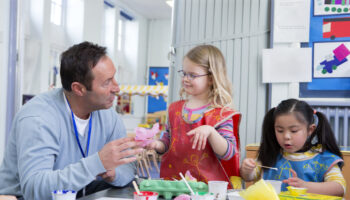Megan Showalter
One of my favorite activities from my teaching days and my years parenting a young child was reading out loud. I made sure my classrooms were full of opportunities to explore the world through books, and shopping trips with my son often ended in a stop at the book store where he could pick out one book to add to his collection. Some of my fondest teaching memories are of having a child in my lap while reading a story – especially the one little one that would suck his thumb and reach up and play with my earlobe while I read. My son and I flew through reading the Harry Potter series together at bed time when he was in grade school.
I knew I was fostering language growth and a love of reading for all those children, but I recently read some articles that showed not only how important all those words they heard me say were, but also some ways I could have enriched my support for their development. Did you know:
- As adults we tend to choose frequently used words and patterns of speech when talking to children? This tends to limit their exposure to new words that
 help expand their vocabulary. Reading books to children provides opportunities to introduce new words – even picture books are up to three times as likely to have new words not among those we use most commonly!
help expand their vocabulary. Reading books to children provides opportunities to introduce new words – even picture books are up to three times as likely to have new words not among those we use most commonly! - Reading to babies and toddlers is just as important as reading to older children? Earlier exposure to language supports gaining a larger vocabulary and deeper understanding of grammar throughout a person’s life. It is the beginnings of a solid foundation for literacy.
- Children gain and practice listening skills when they are being read to? To be a good reader, one needs to also be a good listener.
Also, it’s not just about talking AT children. Reading stories to children without giving them opportunities to respond is the same as talking at them. Back and forth exchanges – actual conversations are even more stimulating to children’s brains! Ask them questions about the pictures on the pages. Define those new words in terms they understand. As them to predict what might happen next in the story, or why a character said or did something specific. Wait for their answer and then respond with more information. Back and forth loops! That’s what really fosters brain development. Studies show it changes the amount of activity in certain areas in a child’s brain! Even for young children who respond to your talk with sounds or facial gestures, turn taking conversations have the same brain growth effect.
Conversations can happen anywhere and be about anything. As a parent one of the best places I found to have conversations with my son was while we were driving around town. As a teacher there are probably a million different times during an average day to have a conversation with one or more children in your group. So, jump in and let the children’s interests lead the way. For example:
- During free play stop in to more than one interest center and listen to the children’s conversation then join in. Ask questions, introduce new words, add information that will help them expand their play.
- During routine care talk to children about the process of washing hands, changing a diaper, or eating a meal. For older children who are learning self-help skills name the steps of completing the tasks and ask them for what comes next. Purposely leave out a step and then admit you forgot something. Ask them to name what you missed. Make a game of it! Or simply have a conversation with them about their day.
Sources:
Frey, S. (2015, July 8). Study says reading aloud to children, more than talking, builds literacy. Retrieved from http://edsource.org
Trafton, A. (2018, February 13). Back-and-forth exchanges boost children’s brain response to language. Retrieved from http://news.mit.edu




